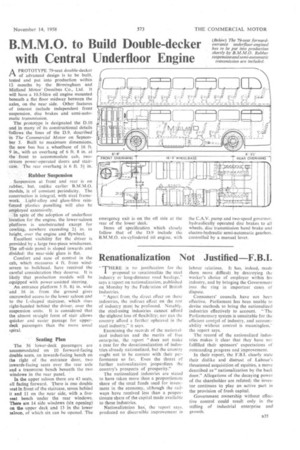B.M.M.O. to Build Double-decker with Central Underfloor Engine
Page 69

If you've noticed an error in this article please click here to report it so we can fix it.
A PROTOTYPE 79-seat double-decker rA of advanced design is to be built, tested and put into production within 12 months by the Birmingham and Midland -1Vlotqf Omnibus Co., Ltd. It will have a 10.5tli1re oil 'engine Mounted beneath a flat floor midway between the axles, onthe near side. Other features of interest include independent front suspension, disc brakes and semi-auto
matic transmission. . .
The .prototype is designated the 15.10 and in Many of its constructional details 'follows the lines of• the D,9, described in The Commercial Motor on September 5. Built to maximum dimensions, the new, bus has a wheelbase of 16 ft, in., with an overhang of 6 ft. 8 in. at the front to accommodate cab, twostream power-operated doors and staircase. The rear overhang is 6 ft. 5+ in.
Rubber Suspension . Suspension at front and rear is on rubber, but, unlike earlier B.M.M.O.• Models, is of constant periodicity. The construction is integral, with steel framework. Light-alloy and glass-fibre reinforced :plastics panelling will also be employed extensively.
In spite of the adoption of underfloor location for the engine, the lower-saloon platform is unobstructed except for cowling, nowhere exceeding 21 in. in height, over the engine and flywheel.
Excellent visibility for the driver is provided by a large two-piece windscreen. The off-side panel is sloped inwards and divided; the near-side glass is flat.
Comfort and ease of control in the cab, which: measures 4 ft. from windscreen to bulkhead, have received the careful consideration they deserve. It is likely that production models will he equiPped with power-assisted steering.
An entrance platform 3 ft. 8* in. wide and 16 in. from the ground gives uncrowded access to the lower saloon and to the L-shaped staircase,. which rises right-handed behind the driver, over the suspension units. It isconsidered that the almost straight form of stair allows quicker and easier passage for upperdeck passengers thah the more usual spiral.
Seating Plan The 36 lower-deck passengers are accommodated on 10 forward-facing double seats, an inwards-facing bench on the right of the entrance door, two inwards-facing seats over the rear axle and a transverse bench beneath the two windows in the rear panel.
In the upper saloon there are 43 seats, all facing forward. There is one double seat in front of the staircase, seven behind it and 11 on the near side, with a fiveseat bench under the rear windows. There are 14 side windows (six opening) on the upper deck and 13 in the lower saloon, of which six can be opened_ The emergency, exit is on the off side at the rear of the lower deck:
Items of specification_ which closely follow that of the D.9 include the B.M.M.O. six-cYlindered oil engine, with the C.A.V. pump and two-speed governor. hydradlically operated disc brakes to all wheels, disc transmission hand brake and electro-hydraulic semi-automatic gearbox. controlled by a manual lever,




















































































































